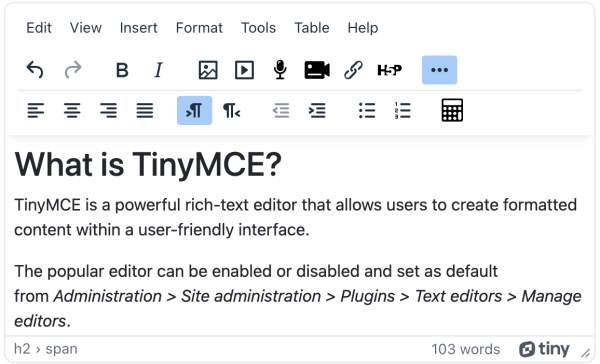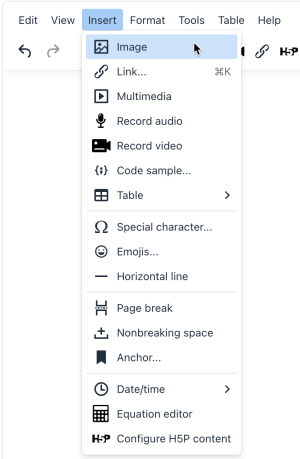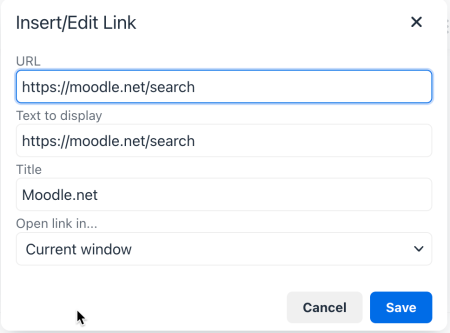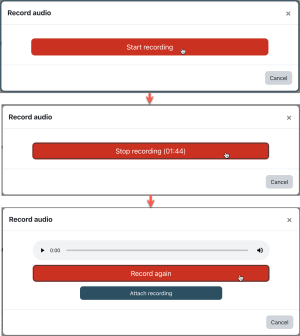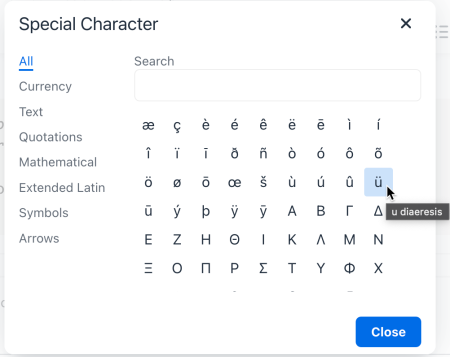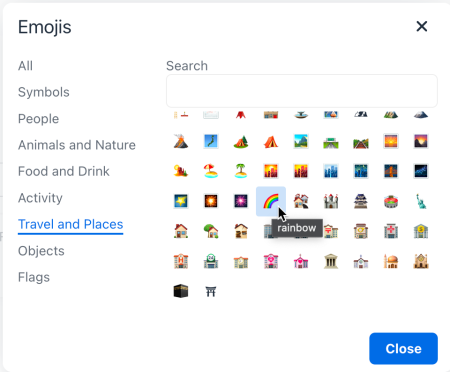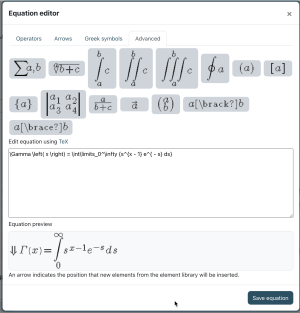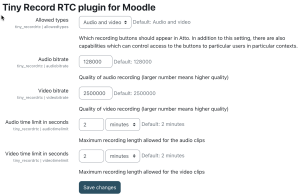42/Editor TinyMCE
- Editor de texto
- Editor Atto
- Editor TinyMCE
- Editor TinyMCE (antiguo) Moodle 4.1 y anteriores
- Formateando texto
- Editor de texto FAQ
| Existe documentación diferente para varias versiones de Moodle: Esta documentación sobre el nuevo editor TinyMCE para Moodle 4.1 y 4.2. La documentación para Moodle 4.3 y más modernos está en Editor TinyMCE. La documentación para el antiguo Editor TinyMCE (antiguo) que era usado en Moodle 2.x y 3.x está en 311/Editor TinyMCE. |
¡Nueva característica
en Moodle 4.1 !
¿Qué es TinyMCE?
TinyMCE es un poderoso editor de texto enriquecido que le permite a los usuarios el crear contenido formateado dentro de una interfaz amistosa al usuario.
El popular editor es el editor predterminado para las nuevas instalaciones de Moodle a partir de Moodle 4.2 en adelante y se pude hacer predeterminado en sitios que se hubieran actualizado a esta versión desde Administración > Administración del sitio > Plugins > Editores de texto > Gestionar editores.
Si se habilita, los usuarios pueden seleccionar al Editor TinyMCE desde el Menú del usuario > Preferencias > Preferencias de editor.
Nota: también estuvo disponible una versión anterior Editor TinyMCE (antiguo), aunque se recomendaba deshabilitarlo si usted estaba planeando usar la versión más nueva. La versión más nueva es más accesible y eventualmente reeplazará al actual predeterminado Editor Atto.
Barra de herramientas Tiny
Los botones siguientes están disponibles en la barra de herramientas (es posible que no todos los botones se muestren en todos los escenarios):
Los botones disponibles son como sigue:
| # | Botón | # | Botón | # | Botón |
|---|---|---|---|---|---|
| 1 | Deshacer | 10 | Alinear Izq | 18 | Lista con viñetas |
| 2 | Re-hacer | 11 | Alinear centro | 19 | Lista numerada |
| 3 | Negritas | 12 | Alinear derecha | 20 | Editor de ecuaciones |
| 4 | Cursivas | 13 | Justificar | 21 | Alternar segunda barra de herramientas (si existiera) |
| 5 | Insertar imagen / modificar propiedades de imagen | 14 | Disminuir sangría | ||
| 6 | Insertar video / modificar propiedades del video | 15 | Aumentar sangría | ||
| 7 | Grabar audio | 16 | Dirección de Izquierda a Der | ||
| 8 | Grabar video | 17 | Dirección de der a izquierda | ||
| 9 | Insertar H5P / modificar propiedades de H5P |
Algunos botones tienen prerequisitos para mostrarse; por ejemplo, el botón del editor de ecuaciones solamente se mostrará si está habilitado MathJax o la notación TeX en ( Administración del sitio > Plugins > Filtros > Gestionar filtros), mientras que la opción H5P solamente se mostrará si la capacidad tiny/h5p:addembed ha sido otorgada.
Características de Tiny
Las siguientes características están disponibles desde el menú Insertar:
Nota: Pendiente de Traducir. ¡Anímese a traducir esta página!. ( y otras páginas pendientes)
Insertar / Editar imagen
La manera más fácil para insertar una imagen es vía arrastrar-y-soltar. de forma alterna, usted puede usar la herramienta para Insertar imagen, la cual le da nmás control sobre algunas de las propiedades de la imagen:
- URL: The (internal or external) address of the image. You can either enter a URL manually or select an image from the repository browser, which adds the URL automatically.
- Description: Unless the image is labelled decorative only, a description must be provided for screenreader users
- Size: Initially, the image's width and height are set. These can be adjusted to fit your text. When the Auto size checkbox remains ticked, the image's width-height ratio stays intact.
- Alignment: Options are Top, Middle, and Bottom.
Para modificar las propiedades de la imagen una vez que ya se ha añadido a su texto, seleccione la imagen y presione el botón Imagen en la mini barra de herramientas que se muestra.
Insertar / Editar Enlace
Al insertar o editar un enlace a otra página (interna o externa), usted puede proporcionar las configuraciones siguientes:
- URL: The address of the page to navigate to. If left empty, the option <top> and <bottom> are available
- Text to display: The text that is shown in the text, represented as a link
- Title: The text shown when hovering over the link
- Browse repositories: Upload a file to link to.
- Open link in...: The page can either be opened in the Current Window or a New window
Insertar / Editar Multimedios
Para insertar clips de audio o video existentes, el editor TinyMCE soporta la Interfase para incrustación de medios estándar de Moodle.
Grabar audio y video
TinyMCE le permite a los usuarios el grabar audio y video clips que s epegarán al texto una vez grabados. Cada grabación comprende tres pasos:
- Start recording: when ready, press the Start recording button
- Stop recording: when completed, press the Stop recording button
- Review recording: you can listen to or watch the recording via the provided controls. Either attach the clip to your text or record it again.
La longitud y calidad (bitrate) puede ser configurada a nivel del administrador.
Insertar / Editar código
The Tiny editor lets you insert and embed syntax color highlighted code snippets into the editable area.
While you can select the (programming) language at the top, it doesn't have any impact on the way the code is displayed.
Tiny also supports formatting of code elements (Format -> Code), which changes the selected text to the internally defined code style.
Insertar Tabla
Tiny comes with comprehensive table management functionality to handle grid-like structures in your text. In addition to the Insert table menu item, an entire main menu has been dedicated to tables.
Once a table has been added, you can customise individual cells, row, columns, and the properties of the entire table. The following self-explanatory menu items are available, all supporting standard HTML table options:
- Cell
- Cell properties
- Merge cells
- Split cells
- Row
- Insert row before
- Insert row after
- Delete row
- Row properties
- Cut row
- Copy row
- Paste row before
- Paste row after
- Column
- Insert column before
- Insert column after
- Delete column
- Cut column
- Copy column
- Paste column before
- Paste column after
- Table properties
- Delete table
The table editor also shows context-sensitive menus when editing different table elements.
Insertar caracteres especiales
The special character picker lets you insert letters and symbols (a map of special unicode characters) that are difficult or impossible to access via your keyboard. You can either search by keyword and / or browse categories.
Insertar Emojis
Bring a smiley to your content: The emoji picker lets you insert pictograms. You can either search by keyword and / or browse categories.
Insertar elementos HTML
The following 4 HTML elements are supported by TinyMCE via menus:
- Insert horizontal line: Adds an HTML line to your text.
- Insert page break: Adds a page break (
<p>) to your text.
- Insert nonbreaking space: Add an nonbreaking space (
) at the current cursor location.
- Insert anchor: Insert anchors (sometimes referred to as a bookmarks) to your text. Users will be prompted via a dialog box to enter a string. The string will be inserted into the HTML as an anchor id at the location of the cursor. For example, a user places their cursor at the beginning of "Moodle" and clicks on the anchor button and enters "start" in the dialog box. The resulting HTML will take the form of
<p><a id="start"></a>Moodle</p>.
Insertar fecha/hora
The Insert date/time options lets you easily insert the current date and/or time into the editable area at the cursor insertion point.
The available format options depend on the selected language.
Editor de ecuaciones
If either the MathJax or the TeX filters are enabled (in Site administration > Plugins > Filters > Manage filters) then the Insert equation option is provided in the TinyMCE editor for launching the equation editor.
Internally, the equation editor uses the TeX notation which can either be entered manually and / or interactively. The interactive elements are grouped into 4 categories (Operators, Arrows, Greek symbols, and Advanced). The content of each tab can be configured via the Equation editor settings.
At the bottom of the editor, a preview is shown.
Configurar contenido H5P
You can embed H5P content via the Configure H5P content menu as follows:
- Browse the Content bank repository and select an H5P file
- Choose to either make a copy of the file or create a shortcut
- Optionally, configure the H5P options (Allow download, Embed button, Copyright button)
- Click the button 'Select this file'
- Click 'Insert H5P'These steps will automatically enter the internal address in the H5P URL field. Alternatively, you can enter any internal or external H5P URL manually.
Note: If you create a shortcut to the file, you can edit it in the Content bank and any activities with a link to the file will be updated.
Herramientas de Tiny
The following tools are available in vie the Tools menu:
Ver código fuente
The source code pop up window displays the code of the page, usually HTML or JS. The code can be modified in plain text; once the window is closed, any changes will be reflected in the WYSIWYG mode.
Contar palabras
The word pop up windows displays the number of words and the number of characters (with and without spaces) of the entire document and the selected text, respectively.
The number of words are also shown in the editor's footer.
Comprobador de accesibilidad
El comprobador automatizado de Accesibilidad comprueba si existieran algunos errores comunes en el texto. Estos usualmente son elementos sobre la forma en la cual está construido el texto que pueden evitar que todos los usuarios tengan igual acceso a información y funcionaliadad. La lista de problemas que el revisor de accesibilidad busca es:
- Imagágenes con texto alt faltante o vacío (a menos que tengan el rol de presentación)
- Contraste de color de letras y color del fondo que cumpla con WCAG las guías de AA
- Largos bloques de texto que estén suficientemente divididos en encabezados
- Todas las tablas requieren subtítulos
- Las tablas no deben contener células juntadas ya que son difíciles para navegar con lectors de pantalla en voz alta.
- Todas las tablas deben contener encabezados de dila o columna
Gestor de medios
The media manager shows all media files that have been embedded in the text.
The top part of the media manager shows the familiar file management element where you can add, download, and delete attached files.
Files that have been attached and deleted again are shown at the bottom half of the screen.
Atajos de teclado
The following keyboard shortcuts will work in the Tiny text editor in most browsers. Note that for many of these commands to work you need to either click in the text editor or select content in the text editor.
Atajos del editor
| Windows Command | Mac Command | Function |
|---|---|---|
| Ctrl + Shift + f | ⌘ + Shift + f | Full screen toggle |
| Ctrl + c | ⌘ + c | Copy |
| Ctrl + v | ⌘ + v | Paste |
| Ctrl + Shift + v | ⌘ + Shift + v | Paste without formatting (very useful) |
| Ctrl + x | ⌘ + x | Cut |
| Ctrl + z | ⌘ + z | Undo |
| Ctrl + y | ⌘ + y | Redo |
| Ctrl + a | ⌘ + a | Select all |
| Ctrl + f | ⌘ + f | Find and replace |
| F3 | Find next | |
| Shift + F3 | Find previous | |
| Ctrl + b | ⌘ + b | Bold |
| Ctrl + i | ⌘ + i | Italics |
| Ctrl + u | ⌘ + u | Underline |
| Ctrl + k | ⌘ + k | Insert/edit link |
| Ctrl + Right arrow | Option + Right arrow | Move to the end of the next word |
| Ctrl + Left arrow | Option + Left arrow | Move to the end of the previous word |
| Ctrl + Shift + Right arrow | Shift + Option + Right arrow | Select the next word or letter |
| Ctrl + Shift + Left arrow | Shift + Option + Left arrow | Select the previous word or letter |
| Ctrl + Shift + Home | Select from the cursor to the beginning of the page | |
| Ctrl + Shift + End | Select from the cursor to the end of the page | |
| Ctrl + Home | ⌘ + Up arrow | Move to the beginning of the page |
| Ctrl + End | ⌘ + Down arrow | Move to the end of the page |
| Ctrl + Backspace | Delete word or letter to the left | |
| Ctrl + Delete | Delete word or letter to the right | |
| Ctrl + P | ⌘ + P | |
| Alt+Shift+1 | Ctrl+Option+1 | Header 1 |
| Alt+Shift+2 | Ctrl+Option+2 | Header 2 |
| Alt+Shift+3 | Ctrl+Option+3 | Header 3 |
| Alt+Shift+4 | Ctrl+Option+4 | Header 4 |
| Alt+Shift+5 | Ctrl+Option+5 | Header 5 |
| Alt+Shift+6 | Ctrl+Option+6 | Header 6 |
| Alt+Shift+7 | Ctrl+Option+7 | Paragraph |
| Alt+Shift+8 | Ctrl+Option+8 | Div |
| Alt+Shift+9 | Ctrl+Option+9 | Address |
| Alt+0 | Option+0 | Help dialogue (list of shortcuts) |
| Ctrl and + | ⌘ and + | Zoom in (not specific to the editor, but very useful) |
| Ctrl and - | ⌘ and - | Zoom out (not specific to the editor, but very useful) |
| Ctrl and 0 | ⌘ and 0 | Reset zoom (not specific to the editor, but very useful) |
| Double-click | Double-click | Select word |
| Triple-click | Triple-click | Select line |
The sections of the outer UI of the editor - the menubar, toolbar, sidebar and footer - are all keyboard navigable.
There are multiple ways to activate keyboard navigation:
- Focus the menubar: Alt + F9 (Windows) or ⌥F9 (MacOS)
- Focus the toolbar: Alt + F10 (Windows) or ⌥F10 (MacOS)
- Focus the footer: Alt + F11 (Windows) or ⌥F11 (MacOS)
Focusing the menubar or toolbar will start keyboard navigation at the first item in the menubar or toolbar, which will be highlighted with a gray background. Focusing the footer will start keyboard navigation at the first item in the element path, which will be highlighted with an underline.
Moverse entre secciones de la Interfaz del Usuario
When keyboard navigation is active, pressing tab will move the focus to the next major section of the UI, where applicable. These sections are:
- the menubar
- each group of the toolbar
- the sidebar
- the element path in the footer
- the wordcount toggle button in the footer
- the branding link in the footer
- the editor resize handle in the footer
Pressing shift + tab will move backwards through the same sections, except when moving from the footer to the toolbar. Focusing the element path then pressing shift + tab will move focus to the first toolbar group, not the last.
Moverse dentro de secciones de la Interfaz del Usuario
La navegación por teclado detro de secciones de la Interfaz del Usuario usualmente puede lograrse usando las flechas del teclado izquierda y derecha. Esto incluye:
- moverse entre menúes en la barra del menú
- moverse entre botones en un grupo de la barra de herramientas
- moverse entre elementos en la ruta de elementos
En todas estas secciones d ela Interfaz del Usuario, la navegación por teclado ciclará adentro de la sección. Por ejemplo, al enfocar en el último botón en un grupo en la barra de herramientas y después presionar la flecha derecha se moverá el foco hacia el primer elemento en el mismo grupo de la barra de herramientas.
Ejecutar botones
To execute a button, navigate the selection to the desired button and hit space or enter.
When focusing a menubar button or a toolbar button with a menu, pressing space, enter or down arrow will open the menu. When the menu opens the first item will be selected. To move up or down the menu, press the up or down arrow key respectively. This is the same for submenus, which can also be opened and closed using the left and right arrow keys.
To close any active menu, hit the escape key. When a menu is closed the selection will be restored to its previous selection. This also works for closing submenus.
Menúes y barras de herramientas contextuales
To focus an open context toolbar such as the table context toolbar, press Ctrl + F9 (Windows) or ⌃F9 (MacOS).
Context toolbar navigation is the same as toolbar navigation, and context menu navigation is the same as standard menu navigation.
There are two types of dialog UIs in TinyMCE: tabbed dialogs and non-tabbed dialogs.
When a non-tabbed dialog is opened, the first interactive component in the dialog will be focused. Users can navigate between interactive components by pressing tab. This includes any footer buttons. Navigation will cycle back to the first dialog component if tab is pressed while focusing the last component in the dialog. Pressing shift + tab will navigate backwards.
When a tabbed dialog is opened, the first button in the tab menu is focused. Pressing tab will navigate to the first interactive component in that tab, and will cycle through the tab’s components, the footer buttons, then back to the tab button. To switch to another tab, focus the tab button for the current tab, then use the arrow keys to cycle through the tab buttons.
Atajos de accesibilidad
Esta es una lista de atajos de teclado disponibles dentro de la interfaz del usuario del editor.
| Comando en Windows | Comando en Mac | Función |
|---|---|---|
| Enter / Spacebar | Enter / Spacebar | Execute command |
| Tab | Tab | Focus on next UI Element(such as: Menu bar, Toolbar, Toolbar Group, Status Bar Item) |
| Shift+Tab | Shift+Tab | Focus on previous UI Element(such as: Menu bar, Toolbar, Toolbar Group, Status Bar Item) |
| Right Arrow / Down Arrow | Right Arrow / Down Arrow | Focus next Control(such as: toolbar button, menu, or menu item) |
| Left Arrow / Up Arrow | Left Arrow / Up Arrow | Focus previous Control(such as: toolbar button, menu, or menu item) |
| Down Arrow / Spacebar | Down Arrow / Spacebar | Open menu or toolbar menu button |
| Spacebar | Spacebar | Open group toolbar button |
| Down Arrow | Down Arrow | Open split toolbar button |
| Shift+Enter | Shift+Enter | Open the popup menu on split toolbar buttons |
| Right Arrow | Right Arrow | Open submenu |
| Left Arrow / Esc | Left Arrow / Esc | Close submenu |
| Esc | Esc | Close dialog |
| Esc | Esc | Close menu |
| Esc | Esc | Move focus back to editor body |
Note: Browsers and Screen Readers provide additional shortcuts within the editor context.
Configuraciones de la administración del sitio
Configuraciones del editor de ecuaciones
The equation editor has 4 tabs: Operators, Arrows, Greek symbols, and Advanced. The commands that are available on each tab and their order can be configured in Site administration > Plugins > Text editors > TinyMCE editor > Equation editor settings.
For each group, the list of commands is shown in TeX format.
Plugin Tiny para grabar RTC para Moodle
Tiny fully supports media recording through. Internally, RecordRTC is utilised, an open source JavaScript library using WebRTC for audio and video recording. To configure its settings, navigate to Site administration > Plugins > Text editors > TinyMCE editor > RecordRTC:
The following options have an impact on server resources, both in terms of bandwidth and disk usage:
- Allowed types: You can specify whether Audio and video recording are supported or Audio only or Video only. There are two capabilities to control access to the TinyMCE buttons: Capabilities/tiny/recordrtc:recordvideo and Capabilities/tiny/recordrtc:recordaudio
- Audio bitrate and Video bitrate: The lower the bitrates, the smaller the file sizes, and vice versa. The default bitrate for recorded audio (128000) should generate files of about 15 KB per minute; the default bitrate for recorded video (2500000) to files of approximately 20 MB per minute.
- Audio time limit in seconds and Video time limit in seconds: The default time limit is 2 minutes for audio and video recording. Again, the longer the maximum recording length, the bigger the resulting files.
Recordings are stored in subdirectories of $CFG->dataroot>/filedir. Ensure post_max_size and upload_max_filesize are configured in line with your expected maximum recording sizes.
Configuraciones generales
The editor shows a small "Power by Tiny" icon in the footer that includes a link to the Tiny editor web site. You can show/hide this icon by enabling/disabling the Tiny branding option.
